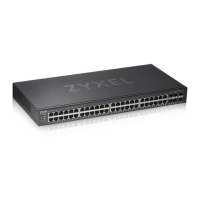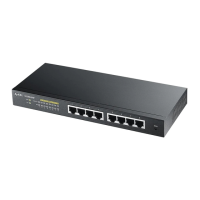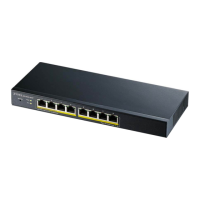GS1920 Series User’s Guide
220
CHAPTER 26
IP Source Guard
26.1 IP Source Guard Overview
Use IPv4 source guard to filter unauthorized DHCP and ARP packets in your network.
IP source guard uses a binding table to distinguish between authorized and unauthorized DHCP and
ARP packets in your network. A binding contains these key attributes:
•MAC address
•VLAN ID
•IP address
• Port number
When the Switch receives a DHCP or ARP packet, it looks up the appropriate MAC address, VLAN ID,
IP address, and port number in the binding table. If there is a binding, the Switch forwards the
packet. If there is not a binding, the Switch discards the packet.
26.1.1 What You Can Do
•Use the IP Source Guard screen (Section 26.2 on page 221) to display the links to the
configuration screens where you can configure IPv4 or IPv6 source guard settings.
•Use the IPv4 Source Guard Setup screen (Section 26.3 on page 222) to look at the current
bindings for DHCP snooping and ARP inspection.
•Use the IP Source Guard Static Binding screen (Section 26.4 on page 222) to manage static
bindings for DHCP snooping and ARP inspection.
•Use the DHCP Snooping screen (Section 26.5 on page 224) to look at various statistics about
the DHCP snooping database.
•Use this DHCP Snooping Configure screen (Section 26.6 on page 227) to enable DHCP
snooping on the Switch (not on specific VLAN), specify the VLAN where the default DHCP server
is located, and configure the DHCP snooping database.
•Use the DHCP Snooping Port Configure screen (Section 26.6.1 on page 229) to specify
whether ports are trusted or untrusted ports for DHCP snooping.
•Use the DHCP Snooping VLAN Configure screen (Section 26.6.2 on page 231) to enable DHCP
snooping on each VLAN and to specify whether or not the Switch adds DHCP relay agent option
82 information to DHCP requests that the Switch relays to a DHCP server for each VLAN.
•Use the DHCP Snooping VLAN Port Configure screen (Section 26.6.3 on page 232) to apply a
different DHCP option 82 profile to certain ports in a VLAN.
•Use the ARP Inspection Status screen (Section 26.7 on page 233) to look at the current list of
MAC address filters that were created because the Switch identified an unauthorized ARP packet.
•Use the ARP Inspection VLAN Status screen (Section 26.8 on page 234) to look at various
statistics about ARP packets in each VLAN.

